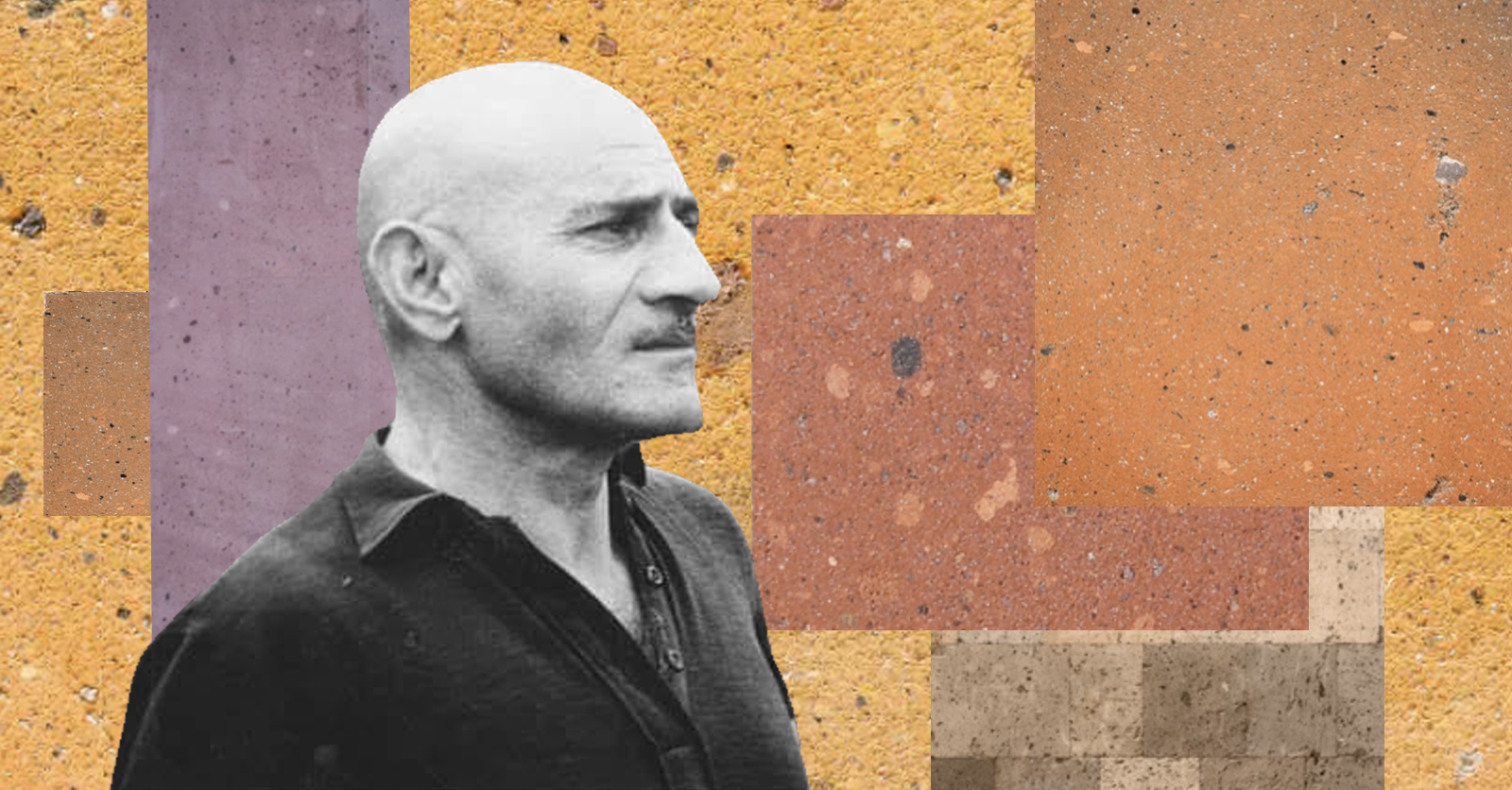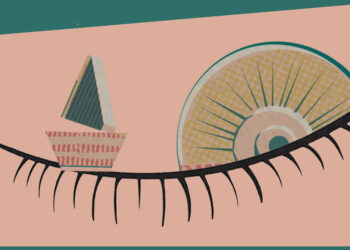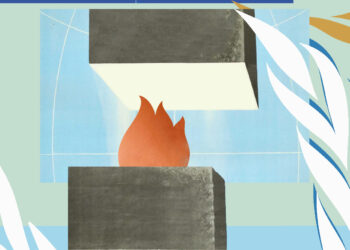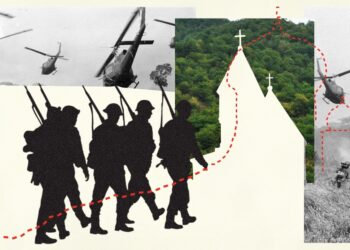
Listen to the article.
In 1934, a young architecture student at the Leningrad Academy of Fine Arts [1] inscribed his capstone, entitled “Riverside Station” with the following words: “Ode to Armenia, ode to your waters, ode to your mountains, ode to Karabakh…” This daring dedication, overflowing with national pride, caused a stir among his professors. That student was Rafayel Israelyan.
Today, Israelyan is celebrated as one of the most prolific architects in the Armenian world. His visionary designs, encompassing a wide range of structures—memorials, fountains, bridges, churches, government buildings, and more—have left an indelible mark on Armenia’s architectural landscape.
Tbilisi – Leningrad – Yerevan
Born in 1908 in Tbilisi to a family of teachers, Israelyan’s paternal lineage went back to Shushi, while his maternal roots were in Nakhichevan. Architect Edmond Tigranyan, Israelyan’s schoolmate, recalls that Israelyan didn’t gravitate toward any particular subject. “He was of average height, slim, lean, and broad-shouldered. He dressed lightly, keeping his collar open year-round. His movements were quick, nimble, and flexible. He had the posture of an athlete. He joined school games with enthusiasm, fully absorbed but always showing restraint, maintaining a dignified presence. He had a sharp wit, appreciated others’ humor, and responded in kind.”[2] It was only after graduation that they discovered he had enrolled in a technical school.
However, as Tigranyan recalls, after finishing his first year there, Israelyan decided to travel with a friend on the Tbilisi-Moscow-Far East railway after “getting a free travel ticket.”
While in Moscow, Israelyan visits an exhibition that would be pivotal to his future. “What amazing things! I’m not looking further, I’m going back home to pursue this as a career,” Israelyan had said. [3]
In 1926, Israelyan enrolled in the Faculty of Architecture at Georgia’s Academy of Arts. He continued his studies in Leningrad from 1929 to 1936, including at the Ilya Repin Leningrad Institute for Painting, Sculpture and Architecture.
During this time, Israelyan brought together over 40 Armenian students studying at the academy who had previously had little interaction. Painter Tsolak Azizyan reminisces about Israelyan, “Our conversations would last late into the night, centered on our distant, small homeland, our villages, architectural monuments, literature, and art.”[4]
In his 1965 short story, When They Say “Armenia”, I Instinctively Stand Up,[5] Israelyan recounts his first encounter with his homeland Armenia, “It was 1915… just an ordinary day when that name pierced my young mind. That morning, as they brought the daily newspaper to our house, I noticed its unusual color—all pages were printed in red letters. When I asked about it, my father explained that Armenia had been drenched in blood, and in reporting this tragedy, the newspaper was printed in the color of blood.”
Growing up and learning more about the history of his people, Israelyan decided to contribute to its healing. At the end of the story, reflecting on 50 years of learning about Armenia, he wrote: “And we architects have committed to the great work of building our mountainous land, to making our Armenia even more beautiful, to making its villages and cities flourish with splendor, so that our young generation can know and love their homeland even more.”
In 1936, Israelyan moved to Yerevan with his wife, Sofia Muradyan, whom he had married two years earlier. His arrival seemed almost symbolic, as it coincided with the passing of architect Alexander Tamanyan, the visionary often regarded as “the founder of beautiful Yerevan.” Israelyan deeply admired Tamanyan, a sentiment he expressed poignantly in his short story Architect Tamanyan and the Children:
“I passed through the park where a stone bears an inscription stating that Alexander Tamanyan’s statue will be erected here. As I walked by that stone, I instinctively took off my hat. How much we owe this great man…”[6]
Israelyan’s reverence for Tamanyan’s legacy would go on to influence his own architectural contributions to Armenia.
The Master of Architectural Forms, Both Large and Small
Israelyan’s first significant project in Yerevan was the Ararat Brandy-Wine-Vodka Factory, situated on the grounds of the historic Yerevan Fortress.
Departing from the simplistic and repetitive stylistics of industrial constructions of that era, Israelyan gave the factory fortress-like walls with arcades––a nod to its historical location.
He also continued the ancient Armenian tradition of leaving inscriptions on walls, bridging past and present. He inscribed in Armenian and Russian that Alexander Griboyedov’s play “Woe from Wit” had premiered at the factory in the author’s presence in 1827. Another inscription praises laborers and urges appreciation for builders.
Israelyan, deeply versed in world literature and folklore of Armenia and other cultures, often drew inspiration from these sources in his works. At the factory, a relief above the arched entrance depicts the famous parable calling for moderation in drinking wine––just enough to “slay the lion.” Another relief illustrates the parable of the fox unable to reach grapes, claiming they were too sour to eat. The construction of the building, however, was not completed during the architect’s lifetime. In the early 1970s, Israelyan wrote: “This is an endless tale, a long novel, whose characters are always changing. New characters keep appearing to carry on the work of those before them, expanding and enhancing the magnificent cellars of Armenian wine. Step by step, this factory gets closer to its main form and will stand tall as a formidable fortress over the rocky cliffs of the Hrazdan Valley.”
The factory’s construction was fully completed only in 2012 with the addition of the administrative tower on the western side, fulfilling Israelyan’s vision.
Israelyan lived and created during a socially and politically challenging time. His sister’s granddaughter, architect Manushak Titanian, recalls two important figures in her life: her grandfather, a man of strength who bluntly resisted Soviet authorities and was executed in 1937, and her great uncle Israelyan, whom she remembers as a quiet but persistent man who steadily pursued his goals. “My grandfather was, in a sense, strong, but he didn’t accomplish much because he was executed. Israelyan was more reserved, seemingly silent, and yet achieved a great deal.”
During World War II, Israelyan proposed commemorating war heroes through fountain-monuments. Years later, on his 50th birthday, the renowned poet Hovhannes Shiraz would write of Israelyan:
“As long as the waters of Armenia murmur,
Your name, turned into a fountain, will resonate…”[7]
The first fountains designed by Israelyan were built in Parakar and Stepanavan as early as 1943. Even after the war, alongside his large-scale projects, he continued to design fountains, adding to his rich legacy of delicately carved small architectural forms.
Architect Mark Grigoryan recalls[8] that Israelyan would be designing these structures not only in his workshop but also during meetings and even in cafes. “It seemed his hands were restless unless they were drawing,” Grigoryan noted. “He sketched fountain-monuments, decorative signposts with eagles or lions for roads, often inventing charming forms of these fountains with great love. He also sketched ceramic tableware, jewelry, and illustrations for books.”
The Triumph of Victory Park
In 1944, Soviet authorities decided to construct a triumphal arch in Yerevan, and Israelyan’s design was chosen in the competition. Later, plans were amended to commission an entire complex honoring the Soviet victory in WWII. Having won the previous competition, Israelyan was entrusted to design the monument. True to form, Israelyan—who always appreciated Armenian architectural legacy—incorporated intersecting arches and domed temple compositions. This design would become a museum and the pedestal for the 22-meter high statue of Mother Armenia that stands today. The project earned him the highest Soviet honor: the USSR State Prize.
The 30-meter-tall structure was inaugurated in 1950 as a pedestal for the 17-meter statue of Stalin. In 1970, on the 25th anniversary of Victory Day, the “Armenia in the Great Patriotic War, 1941-1945” museum opened within the pedestal’s 3,000 square-meter interior space. In 1995, the museum was renamed the “Mother Armenia Military Museum,” featuring two main themes: “The Armenian People’s Participation in World War II” and “The Artsakh Liberation War.” In 1982, Israelyan’s son, Areg Israelyan, completed an arch designed by his father, which became the main entrance to the park.
Israelyan, an architect with a keen eye for building materials and colors, chose Yerevan’s dark brown tuff stone for this structure. This choice harmonized the building with the surrounding hills and the heights upon which it stood. As was his custom, he meticulously crafted the small forms and decorative elements around the monument, personally overseeing every detail on his construction site. Literary scholar Aram Ghanalanyan, in his book dedicated to Israelyan, writes, “One by one he would gently caress the ornaments carved at the main entrance of the monument, the stones brought to life by his imagination, like a parent stroking a beloved child’s curls…”[9]
Ghanalanyan knew Israelyan since their school days in Tbilisi. They later moved to Yerevan, where they collaborated closely and even became in-laws—Israelyan’s daughter married Ghanalanyan’s son. Their grandson, architect Aram Ghanalanyan, now dedicates himself to preserving and promoting Israelyan’s legacy.
In the 1960s, as restaurant culture gained popularity in Armenia, a new restaurant—Aragil (Stork)—opened atop Victory Park in 1960. Built with white stone, it featured an entrance of five arches and a relief of a stork perched on one leg on the eastern wall. Initially, the plan was to name the restaurant after this bird, symbolic to Armenians. However, at the last moment, superiors decided to name it “Moscow” to please the elites. When Israelyan’s objections were disregarded, he requested a meeting with Yakov Zarobyan, First Secretary of the Central Committee of the Communist Party of Armenia. Just two days later, the word “Aragil” adorned the restaurant’s front.
In a book dedicated to Israelyan, artist Tsolak Azizyan writes, “He was very pleased when the Aragil Restaurant was built. We would often spend time there with family and friends. He rarely spoke about the building itself, but he admired the view of Yerevan and Mount Ararat from there. He would suggest we go to the pavilion on the right—specifically built to enjoy the view of Mount Ararat.”[10] This restaurant, with its unique location overlooking Yerevan, has been since privatized and left neglected for decades and is now deteriorating.
Restaurants designed by Israelyan were built not only in Yerevan, but also in Vanadzor and Hrazdan.
Israelyan also made significant contributions to residential architecture. His early works include several notable buildings that are still in use today: a four-story building on Nalbandyan Street (1937), an arched five-story building on Bagratunyats Street (1954), and another five-story building on Mashtots Avenue (1956).
Israelyan believed that typical residential designs should be “the best of the best”, as they would be replicated many times. He argued that cities built with such designs should please the eye. To illustrate his point, he often cited the example of Shushi: “In this city, houses are generally two or three stories high, with rough-cut stone walls. Windows framed by meticulously carved large stones, and arched entrances leading to the yards are surrounded by stone as well. Here, monotony or dullness is out of the question.”[11]
Israelyan adored Mount Ararat and believed that Yerevan’s streets should be designed to showcase this natural wonder. His well-known “Temple of Ararat” (also known as “Charents’ Arch”) on the road to Garni stands as Israelyan’s tribute to the mountain.
Israelyan worried that the rapidly multiplying high-rise buildings might eventually obscure natural vistas such as Mount Aragats, the Hrazdan River, and Getar Creek. He proposed elevating the creek’s waters and creating rest areas along its banks. Sadly, the course of the river would later be altered, with its visible sections in the city covered.
Israelyan also held a special reverence for Yerevan’s old houses, believing they should be carefully preserved and restored to maintain their utility. Ironically, the architect’s own home—which he designed and built himself—has not been preserved.
A Vision for Yerevan’s Streets
In 1936, after moving to Yerevan and spending a few months in rented accommodation, Israelyan received a plot of land on Moskovyan Street. Other renowned artists, such as Martiros Saryan, Hakob Kojoyan, and Varazdat Harutyunyan, also resided there. Israelyan began constructing his dream home but was only able to complete it in 1954. “It started with one room,” recalls Azizyan. “During rainstorms, the roof leaked everywhere. They had barely any furniture, just a table and two chairs. Eventually, when the other rooms were finished, his house became the most desired gathering place for friends. Anyone could enter that home, alone or in groups, at any time of day.”
Israelyan infused his residence with his artistic touch, meticulously designing and decorating various elements. He carved intricate patterns into wall niches, adding a personal flair. The oak handrails of the staircase leading to the second floor were crafted from his sketches, featuring lily motifs that, when viewed as a whole, symbolized the tree of life. In his study, custom wooden shelves bore carved bird figures at their edges, showcasing his favorite archaeological artifacts. Outside, in the yard beneath a sprawling walnut tree and beside a stone fence, lay his cherished retreat—a simple yet inviting table flanked by benches, where he often found inspiration.
Israelyan’s home was on the state-protected cultural heritage list from 1970 until 2004. It was subsequently removed from the list, sold by his heirs, and demolished by the new owners in 2011. The demolition made way for yet another hotel in central Yerevan, falling victim to the same urban development changes that Israelyan so disliked.
Israelyan’s urban planning sensitivity shone in his work on the Artists’ Union Building, a three-story structure built in 1955-1956 next to Moscow Cinema, adjacent to Yerevan Hotel. For this project, he stressed the importance of harmony with surrounding structures and achieving architectural unity. When asked why he adopted the style of the hotel’s architect, Buniyatyan, rather than asserting his own, Israelyan replied, “We have limited land, but we need to stand proud and dignified on this land and stand in such a way that no one tramples on the other’s foot.”
Israyelyan was also the first to introduce terraced buildings to Armenia, which became widely popular. He applied modern architectural solutions when constructing a sanatorium near the village of Arzakan between 1958 and 1961. This building, with some modifications, still operates today as a hotel.
Israelyan is credited with proposing the idea of building a memorial for the victims of the Armenian Genocide during a 1964 meeting of the Union of Architects. His design of asymmetrical, interwoven khachkars became the first memorial dedicated to the victims of 1915 in Soviet Armenia. It was erected in 1965 at the Mother See of Holy Etchmiadzin, at the request of Vazgen I, the Catholicos of All Armenians, marking the 50th anniversary of the Armenian Genocide.
The 1960s were characterized by close collaboration with the church. Israelyan was tasked with developing sketches for the design and ornamentation of the Descent Altar at the Mother See of Holy Etchmiadzin, as well as designing the High Altar.
During this period, the Armenian diaspora was constructing churches in different communities. The Mother See was consulted on designs and asked to review and provide expert opinions on architectural plans.
The first church designed by Israelyan was the Armenian Church of the Holy Forty Martyrs, which blended Armenian ecclesiastical architectural traditions with contemporary needs. Israelyan also designed the St. Nerses Shnorhali Cathedral in Montevideo and the St. Vartan Armenian Cathedral in New York, though he couldn’t oversee its construction in person. Additionally, Israelyan supervised the restoration of St. Sargis Church in central Yerevan.
Memorializing the Battle of Sardarapat
Among Israelyan’s works, the Sardarapat Memorial Complex holds a special place. Initially, the plan was to erect a commemorative sculpture on the battlefield for the occasion of the 50th anniversary of the victory of the Battle of Sardarapat. However, when presented with a design of a rifle-wielding soldier statue, Israelyan felt a more impactful work was necessary. Taking initiative, he developed several alternative designs.
Two statues of winged bulls flank the complex’s entrance, serving as a gateway. Behind them, slightly set back, stands the bell tower. Initially, Israelyan had planned for a massive 40-meter sword instead of the bell tower. However, these were “silent” times; one could not “go too far,” especially in relation to Turkey. Therefore, he replaced the sword with the bell tower, symbolizing the bells that rallied Armenians to defend against the Turkish army.
To avoid “provoking” the neighboring country, the architect also changed the orientation of the five eagles positioned along the long, wide, green promenade leading up to the bell tower. Instead of facing left toward Turkey, they now face right, toward Armenia. The promenade ends with a semicircular memorial wall adorned with symbolic images and bas-reliefs of fiery horses. At its center is a large arched opening—a pathway leading to the Museum of Ethnography, which completes the memorial complex.
Israelyan also gave this building unique features. It resembles a fortress, with windowless walls and a high, multi-layered dome that ensures ample lighting for the spacious halls. The architect allowed only two narrow windows in this building—one facing Mount Ararat and the other facing Mount Aragats.
Tsolak Azizyan recalls that he had never seen Israelyan as tense and emotional as he was during the planning and construction of the Sardarapat Museum. “He kept saying, ‘These are the last arches being made; times are changing, and arches will soon be rare in our designs,’” Azizyan recounts. “During construction, he would tour the halls, pointing out the intricacies of the interiors, corners, courtyards, and individual walls, each with unexpected and unique designs. And he did all this with a hidden sorrow, as if he knew this would be his final work, his swan song.”[13]
Despite Israelyan’s passion, financial difficulties halted construction on the Museum of the National Liberation Movement. The Armenian State Museum of Ethnography and the National Liberation Movement opened only in 1978, after Israelyan’s death.
Israelyan passed away on September 8, 1973, after a serious illness. He was only 64. Until his last breath, he kept his pencils under his pillow and worked whenever he could muster even a little strength.
“In Moscow, before his surgery, I realized he was aware of the gravity of his illness and only pretending to undergo a routine operation. He would joke, ask questions about the Aparan monument’s construction, and day by day, he faded, weakened, and gradually departed from life and from us…” recalls Azizyan.[14]
Israelyan’s contemporaries considered him exceptional—in his work, in his family life, and among friends. “Even the smallest administrative task weighed on him. He felt at ease only in a creative environment, immersed in work, which was his true element,” writes Mark Grigoryan.[15]
Perhaps this explains why Israelyan never pursued high-ranking positions—he maintained warm relationships with everyone and was admired by all. Despite designing numerous iconic buildings across Armenia, there is still no structure dedicated to his memory. His grandson, Aram Ghanalaryan, notes that there is no memorial honoring Israelyan. In the absence of such recognition, the family entrusted his archives and creative legacy to the Alexander Tamanyan National Museum-Institute of Architecture in 2020, ensuring their preservation for future generations.
Footnotes:
[1] “Rafayel Israelyan in the Memories of His Contemporaries,” Armenian SSR Academy of Sciences Publishing, 1981, Yerevan, page 45.
[2] Ibid., p. 42.
[3] Ibid., p. 45.
[4] Ibid., p. 51.
[5] R. Israelyan, “The Story of My Beard,” Soviet Writer, 1981, Yerevan, page 27.[6] R. Israelyan, “The Story of My Beard,” Soviet Writer, 1981, Yerevan, page 25.[7] “Rafayel Israelyan in the Memories of His Contemporaries,” Armenian SSR Academy of Sciences Publishing, 1981, Yerevan, page 190.
[8] Ibid., p. 17.
[9] Ibid., p. 24.
[10] Ibid., p. 56.
[11] “Rafayel Israelyan,” RA NAS Institute of Arts, Graber Publishing, 2008, Yerevan, page 30.
[12] “Rafayel Israelyan in the Memories of His Contemporaries,” Armenian SSR Academy of Sciences Publishing, 1981, Yerevan, page 53.
[13] Ibid., p. 58.
[14] Ibid., page 58.
[15] Ibid., page 9.
Raw & Unfiltered
On the Road in Armenia
Embarking on a journey through Armenia, Daniel Tahmazyan blends personal reflections with historical and cultural insights. From sacred monasteries to forgotten villages, he explores the rugged beauty, spiritual depth, and enduring connection to homeland.
Read moreWaiting for the Flight to Baku
At Dubai Airport, a Yerevan-bound flight boards beside one for Baku. Karena Avedissian writes about how an outburst from a fellow Armenian traveler reflects the lingering trauma of war and ethnic cleansing.
Read moreThe Keepers of the Goats
Armenia’s conservation success story has led to an unexpected challenge: a growing human-bear conflict. As rangers work to protect the rare Bezoar goats in the Arpa Protected Landscape, the return of brown bears is testing the fragile balance between wildlife and local communities.
Read moreWomen: The Driving Force in Agriculture
In Armenia's agricultural sector, women take on a more prominent role than men. During the hot summer months, women’s work groups move from region to region, laboring in vast fields from dawn. Their work not only supports their families but also sustains the country’s agricultural resilience.
Read more“Welcome” to Armenia’s Experience With Repatriation
Every administration in Armenia since independence has implemented policies aimed at encouraging repatriation, but how successful have they been? Gohar Abrahamyan explains.
Read moreThe Life Cycle of a Yerevan Restaurant
While gastronomic tourism has increased, as well as the number of young, local chefs willing to experiment, Yerevan's evolving restaurant industry is experiencing growing pains.
Read moreThe Greatest Love Story That Never Started: Tereza and Davit
“I set out in search of a great love story that never ended, but perhaps I discovered a story that never truly began,” writes Ella Kanegarian-Berberian, in this poignant story about two artists separated by circumstance and war.
Read moreArmenia’s Cancer Crisis
Armenia faces a cancer crisis driven by lifestyle factors and systemic issues in the healthcare system. Despite advancements, cancer rates have tripled since 1999, highlighting the urgent need for improved screening, treatment access and government funding.
Read moreTowards a Culture of Giving, One Step at a Time
There was a time when large charitable foundations held a monopoly on addressing issues beyond the state's capacity. However, with social media and the ability to raise substantial funds with a single post, the culture of giving in Armenia is evolving.
Read more













